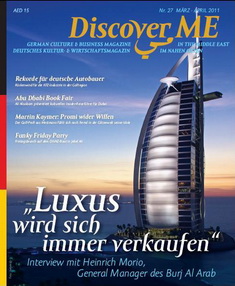
Article:
ISSUE No.4 Mai - June 2007
Burj Dubai
Only the Sky is the Limit
The Burj Dubai (Dubai Tower) is expected to be the tallest building in the world on completion in 2008. The record-breaking plans have a good chance of getting into the Guiness Book of Records. There is still a lot of speculation over the exact height of the building. Nevertheless, it already towers above the city. At Christmas 2006, the shell surpassed the 335-meter Emirates Office Tower, previously the highest building in Dubai.
The technical data of the Burj Dubai sounds like something out of a science fiction novel. The exact dimensions may be unclear but experts predict it will reach at least 700 metres with a total of 154 storeys by the time it is finished, although it could grow to 800 or 900 metres and comprise 175 floors. There has even been talk of 1,011 metres and 216 storeys. The construction companies are trying to fuel the flames of speculation with this media-effective confusion and thus attract even more attention to the mega project. The building is currently 448 metres high and has in sight the 508-meter building in Taiwan, the Taipei 101 Skyscraper. This is currently the tallest building in the world but the builders of the Burj Dubai are giving their all to break the record in the coming months. If you compare this to Cologne Cathedral’s 157 metres, you realise the magnitude of the project. The construction is expected to cost 8 billion US dollars. Thousands of helpers work around the clock in a three-shift system to realise the ambitious undertaking. The plans were drawn up by none other than American star architect Adrian Smith, whose futuristic model caused a sensation even before the first spadeful of earth had been turned.
The 7,000-square-meter ground plan of the skyscraper was designed in the shape of a Y. 45,000 square metres of concrete weighing 110,000 tons were used for the foundations alone and 192 pillars, which were set up to 50 metres into the desert sand, stabilise the structure. The tower rises out of its base like a pyramid. The higher the building becomes, the narrower it gets. Towards the top, the tower shaft becomes helical.
The extreme height is not the only difficulty the engineers face; the climatic conditions constantly pose fresh challenges. For example, chemicals have to be added to the concrete to increase its compressive strength in order to survive the extreme load. Furthermore, it can only be processed at night due to the high daytime temperatures to prevent any damage to the equipment. The design engineers also have to take the region’s strong desert storms into consideration. The higher the building, the more it sways in the wind. Consequently, the architects have to ensure that the residents on the upper floors cannot feel any wind movement.
The Burj Dubai is the only freestanding building of this size in the world. After completion, it should assume the form of an Arabian desert flower with six petals and have an overall floor space of 4,000,000 square metres. An impressive facade made of glass, reflective aluminium and reinforced concrete is due to enshroud the tower at a later date.
A splendid six-star hotel with 403 rooms will occupy the first 37 floors; floors 38 to 108 will consist of apartments which, according to the official records, have already sold out. In total, up to 3,000 people are expected to enjoy the comforts of the futuristic building in luxurious flats. A town within a town – some European villages do not even have as many inhabitants as the Dubai Tower. Above the apartments, there will be offices and large-scale suites. There will be lobby on the 123rd floor and a viewing platform with an outdoor terrace on the 124th floor, of course the highest in the world. 54 lifts will provide the comfortable transport and supply of residents, guests and employees and have been designed in such a way that the double-stack elevator can cover 500 metres in only 55 seconds. This means it transports its passengers into the heavens at a speed of 36 km/h.
The residents of the upper floors will not have to worry about their water supply. Special systems guarantee a warm shower every morning. Further structural challenges have also had to be overcome. For example, in a building of this size, one million litres of condensation form each year. This is collected in an elaborate drainage system and conducted away.
The construction of the tallest building in the world will also have other consequences. The Burj Dubai guarantees that there will be an increase in rent in all of the neighbouring buildings with a view of the colossus. Paris is a prime example of such a development, where you have to dig deep into your pockets if you want an apartment with a view of the Eiffel Tower. There are numerous other examples. However, the tower is not all. A well thought-out plan previews the building of an entire district around the new landmark. With a planned investment sum of 20 billion US dollars, the new district is set to be conjured up out of the desert. Up to 500 advisors are assisting the planners and as many as 20,000 workers are expected to be employed in the busiest phase of the overall project. Consequently, not only is it the tallest tower in the world, it is also the biggest building site.
With the construction of the Burj Dubai, the city is introducing a new age of superlatives and creating an impressive monument. We can only hope that it does not become the new Tower of Babel.
